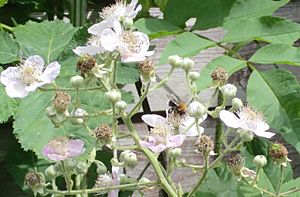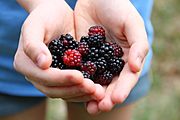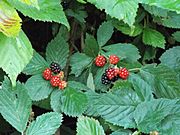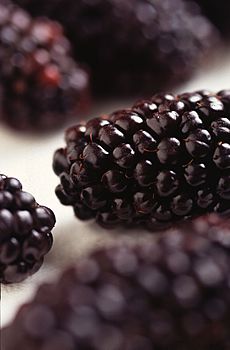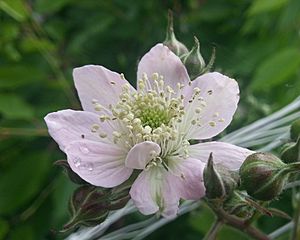Blackberry facts for kids
Quick facts for kids Blackberry |
|
|---|---|
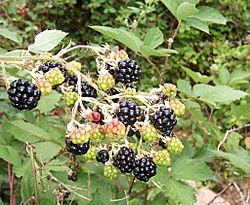 |
|
| Blackberry fruits on the bush. | |
| Scientific classification | |
| Kingdom: | |
| Division: | |
| Class: | |
| Order: | |
| Family: | |
| Genus: | |
The blackberry is a yummy fruit that grows on a plant. It's part of the Rubus genus, which also includes raspberries. In some places, like Britain, the blackberry plant is called a "bramble." But in the western United States, people often call both blackberries and raspberries "caneberries."
Blackberries are found all over the world. They grow in many places, especially in the cooler parts of the Northern hemisphere and South America. There are over 375 different kinds of blackberries! The plant can grow quite tall, up to about 3 meters (10 feet). It makes a black fruit, which is also called a blackberry. These plants can even grow well in poor soil.
Blackberry plants spread quickly. Their strong roots can grow among garden hedges and other shrubs. They can take over empty or wild areas very fast. In some parts of the world, like Australia, Chile, New Zealand, and the Pacific Northwest of North America, some blackberry types are considered weeds because they spread so much.
Contents
Discover the Amazing Blackberry Fruit
What Makes a Blackberry Special?
It's easy to tell a blackberry from a raspberry. When you pick a blackberry, the little stem in the middle (called the torus) stays with the fruit. But when you pick a raspberry, that stem stays on the plant. This leaves a hollow space inside the raspberry.
The word "bramble" means a thick, thorny bush. It's often used for blackberries. But in the United States, "bramble" can mean any plant in the Rubus family. In the western US, "caneberry" is a common word for both blackberries and raspberries.
Even though we call it a berry, a blackberry isn't a true berry in the way scientists define it. Instead, it's an "aggregate fruit." This means it's made up of many tiny little fruits, called drupelets, all joined together.
How Blackberry Plants Grow
Blackberry plants are perennial, meaning they live for many years. They grow new stems, called "canes," from their roots each year.
In its first year, a new cane grows very long, usually 3 to 6 meters (10 to 20 feet). It arches or trails along the ground. This first-year cane is called a primocane. It has large leaves with five or seven parts. It doesn't grow any flowers or fruit in its first year.
In its second year, the cane becomes a floricane. It doesn't grow longer, but it sprouts smaller branches that produce flowers. These branches have smaller leaves with three or five parts. Both first- and second-year canes usually have many sharp prickles. These prickles can be very sharp and make it hard to walk through blackberry bushes! Luckily, some types of blackberries have been grown without prickles.
Wild blackberry plants can form a thick tangle of stems. Their branches can even grow new roots if they touch the ground. Blackberries grow quickly in woods, hillsides, and along fences. They can grow well even in poor soil and often take over empty land.
The flowers appear in late spring and early summer. They grow in small clusters at the ends of the flowering branches. Each flower is about 2 to 3 centimeters (1 inch) wide. They usually have five white or pale pink petals.
For the tiny fruits (drupelets) to grow, each part of the flower needs to be pollinated. This usually happens when pollinators like bees visit the flowers. If there aren't enough bee visits, maybe because of rain or hot weather, the fruit might not form perfectly.
Blackberries in Nature
Blackberry leaves are a food source for some caterpillars. Larger animals, like deer, also enjoy eating the leaves. When the berries are ripe, many animals eat them, including foxes, badgers, and small birds. These animals help spread the blackberry seeds.
Wild blackberries are common throughout most of Europe. They are important for the environment in many countries. Picking wild blackberries is a popular activity. However, these plants can also be seen as weeds because they spread so easily. In places like Australia, Chile, New Zealand, and the Pacific Northwest of North America, some blackberry types are considered invasive species because they are not native and can take over natural areas.
Blackberry fruits are red before they are ripe. This led to an old saying: "blackberries are red when they're green."
People have been eating blackberries for a very long time. Scientists found evidence that a woman from the Iron Age, about 2,500 years ago, ate blackberries.
Why Blackberries Are Good for You
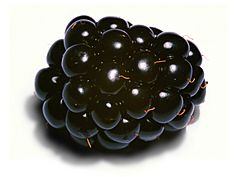
|
|
| Nutritional value per 100 g (3.5 oz) | |
|---|---|
| Energy | 180 kJ (43 kcal) |
|
9.61 g
|
|
| Sugars | 4.88 g |
| Dietary fiber | 5.3 g |
|
0.49 g
|
|
|
Protein
|
1.39 g
|
| Vitamins | Quantity
%DV†
|
| Vitamin A | 214 IU |
| Thiamine (B1) |
2%
0.020 mg |
| Riboflavin (B2) |
2%
0.026 mg |
| Niacin (B3) |
4%
0.646 mg |
| Vitamin B6 |
2%
0.030 mg |
| Folate (B9) |
6%
25 μg |
| Vitamin C |
25%
21.0 mg |
| Vitamin E |
8%
1.17 mg |
| Vitamin K |
19%
19.8 μg |
| Minerals | Quantity
%DV†
|
| Calcium |
3%
29 mg |
| Iron |
5%
0.62 mg |
| Magnesium |
6%
20 mg |
| Phosphorus |
3%
22 mg |
| Potassium |
5%
162 mg |
| Sodium |
0%
1 mg |
| Zinc |
6%
0.53 mg |
|
Link to USDA Database entry
|
|
| †Percentages estimated using US recommendations for adults. | |
Blackberries are full of good things for your body! They have a lot of dietary fiber, vitamin C, and vitamin K. Just 100 grams of raw blackberries (about a handful) has only 43 calories. It also gives you 5 grams of fiber, which is about a quarter of what you need each day. They also provide a good amount of vitamin C and vitamin K.
Blackberries contain both types of fiber: soluble and insoluble. Both are important for a healthy digestive system.
Nutrient Content of Seeds
Blackberries have many small seeds inside. These seeds contain healthy oils, including omega-3 and omega-6 fats. They also have protein, more fiber, and other good compounds.
Food Uses of Blackberries
The soft, juicy blackberry fruit is popular in many desserts. People use them to make jams, jellies, and sometimes even wine. Blackberries are often baked into pies and crumbles, especially mixed with apples. You can also find blackberries in candies.
Blackberries get their rich, dark color from special plant compounds called anthocyanins. These compounds, along with others in blackberries, are being studied by scientists for their potential health benefits.
Growing Blackberries: From Wild to Farm
Mexico is currently the biggest producer of blackberries in the world. Most of their crop is grown to be sent to North America and Europe when blackberries aren't in season there. In the United States, Oregon is a major producer of commercial blackberries.
Many different types of blackberries have been chosen and grown for farms and home gardens. Since different blackberry species can easily create hybrids, there are many types that have more than one species in their family tree.
Different Kinds of Blackberry Plants
There are several main types of cultivated blackberries:
- Trailing Blackberries: These plants grow long, flexible stems that need support, like a trellis. They are not as resistant to cold as other types. They grow well in places with mild climates, like the Pacific Northwest of the United States, the United Kingdom, New Zealand, and Chile.
- Thornless Blackberries: These types don't have prickles, making them much easier to pick! They also need a trellis for support. Some popular thornless types include 'Chester Thornless' and 'Triple Crown'.
- Erect Blackberries: These plants grow more upright and don't always need a trellis. They also spread underground by sending up new canes from their roots. Some types, like 'Navaho' and 'Ouachita', are thornless.
- Primocane-Fruiting Blackberries: These are special because they can produce fruit on their first-year canes (primocanes) in late summer or fall. Most blackberries only fruit on second-year canes. 'Prime-Jim' and 'Prime-Jan' were the first types of these blackberries.
Growing Blackberries in Mexico
Blackberry farming in Mexico has grown a lot recently. The main type grown there is called 'Tupy'. To make these blackberries grow in parts of Mexico where it doesn't get cold enough in winter, farmers sometimes use special methods to make the plants flower.
Keeping Blackberry Plants Healthy
Blackberries can get some of the same diseases as raspberries. One disease, called anthracnose, can make the berries ripen unevenly. To help prevent diseases, farmers keep the areas between blackberry plants clear of weeds and other grasses. It's also important to buy healthy, disease-free plants when starting a blackberry patch.
One serious insect pest for blackberries is the spotted-wing drosophila. This tiny fly lays its eggs under the skin of fresh, ripe fruit. The larvae then grow inside the fruit, which can ruin the berries for sale. Another pest is the blackberry aphid, which also eats raspberries.
Images for kids
See also
 In Spanish: Mora (fruta) para niños
In Spanish: Mora (fruta) para niños


